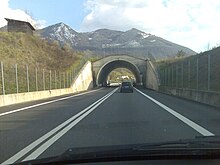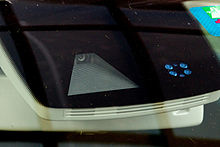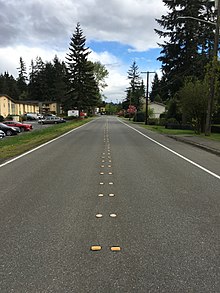
Система предупреждения о сходе с полосы — в дорожно-транспортной терминологии, является механизмом, предназначенным для того, чтобы предупредить водителя, когда автомобиль начинает двигаться из своей полосы движения (за исключением ситуации, когда поворотник включен в этом направлении) на автострадах и магистралях.
Эти системы предназначены для минимизации несчастных случаев и устранения основной причины столкновения: водительской ошибки, рассеянности и сонливости.
Содержание
Типы [ править | править код ]
Существует два основных типа систем:
- Системы, которые предупреждают водителя (lane departure warning — система предупреждения о сходе с полосы, LDW — СПСП), если автомобиль покидает полосу (визуальные, звуковые и/или вибрационные предупреждения)
- Системы, которые предупреждают водителя и, если водитель ничего не делает, автоматически предпринимают действия для того, чтобы удержать транспортное средство на своей полосе (lane keeping system — система удержания полосы движения, LKS — СУПД)
Типы датчиков [ править | править код ]

</li>
<li>Лазерных датчиках (устанавливаются на передней части транспортного средства)</li>
<li>Инфракрасных датчиках (устанавливаются под лобовым стеклом или под днищем автомобиля) [1]</li>
</ul>
<h2 id=)
И система предупреждения о сходе с полосы и система удержания полосы опираются на видимую дорожную разметку. Они, как правило, не могут определять затертую, отсутствующую или некорректную разметку. Разметка, покрытая снегом или старая разметка могут нарушить функционирование системы. [2]
Lane departure warning system — A lane departure warning system (LDW) is a mechanism designed to warn a driver when the vehicle begins to move out of its lane (unless a turn signal is on in that direction) on freeways and arterial roads.The first production LDW system in Europe … Wikipedia
Lane Departure Warning — Der Spurhalteassistent (auch Spurassistent, engl. lane departure warning system (LDW)) warnt den Fahrer eines Fahrzeuges vor dem Verlassen der Fahrspur auf einer Straße. Hierbei sind unterschiedliche optische Systeme und Computer im Einsatz, mit… … Deutsch Wikipedia
Warning system — A warning system is any system of biological or technical nature deployed by an indiv >Wikipedia
Lane — The word lane has several meanings, including and especially: #a portion of a paved road which is intended for a single line of vehicles and is marked by white or yellow lines. #a narrow road or street, usually lacking a shoulder or a median;… … Wikipedia
Lane Keeping Support — Der Spurhalteassistent (auch Spurassistent, engl. lane departure warning system (LDW)) warnt den Fahrer eines Fahrzeuges vor dem Verlassen der Fahrspur auf einer Straße. Hierbei sind unterschiedliche optische Systeme und Computer im Einsatz, mit… … Deutsch Wikipedia
Precrash system — A precrash system is an automobile safety system designed to reduce the severity of an acc >Wikipedia
Autonomous cruise control system — Schematic of Intelligent Cruise Control. The red car automatically follows the blue car. Autonomous cruise control is an optional cruise control system appearing on some more upscale vehicles. The system goes under many different trade names… … Wikipedia
Mobileye — N.V. Type Private held company Industry Automotive Founded 1999 Founder(s) … Wikipedia
Nissan Patrol — Manufacturer Nissan Production 1951–present Assembly Kyushu, Japan (Nissan Shatai Plant) The … Wikipedia
Automobile safety — is the avo >Wikipedia

In road-transport terminology, a lane departure warning system (LDWS) is a mechanism designed to warn the driver when the vehicle begins to move out of its lane (unless a turn signal is on in that direction) on freeways and arterial roads. These systems are designed to minimize acc >[1] [2]
There are three types of systems:
- Systems which warn the driver if the vehicle is leaving its lane with visual, audible, and/or vibration warnings (lane departure warning, LDW)
- Systems which warn the driver and, with no response, automatically take steps to ensure the vehicle stays in its lane (lane keeping assist, LKA/LKS)
- Systems which assist in oversteering, keeping the car centered in the lane, and asking the driver to take over in challenging situations (lane centering assist, LCA)
Contents
Sensor types [ edit ]




A lane detection system used behind the lane departure warning system uses the principle of Hough transform and Canny edge detector to detect lane lines from realtime camera images fed from the front-end camera of the automobile. A basic flowchart of how a lane detection algorithm works to help lane departure warning is shown in the figures.
History [ edit ]
The first production lane departure warning system in Europe was developed by the United States company Iteris for Mercedes Actros commercial trucks. The system debuted in 2000, and is now available on many new cars, SUV’s and trucks. [4]
In 2002, the Iteris system became available on Freightliner Trucks’ North American vehicles. In both these systems, the driver is warned of unintentional lane departures by an audible rumble strip sound generated on the s >[ citation needed ]
2001 [ edit ]
Nissan Motors began offering a lane-keeping support system on the Cima sold in Japan. [5]
2002 [ edit ]
Toyota introduced its Lane Monitoring System [6] on models such as the Caldina and Alphard [7] sold in Japan; this system warns the driver if it appears the vehicle is beginning to drift out of its lane. [8]
2003 [ edit ]
Honda launched its Lane Keep Assist System (LKAS) on the Inspire. [9] [10] It prov >[11] A camera, mounted at the top of the windshield just above the rear-view mirror, scans the road ahead in a 40-degree radius, picking up the dotted white lines used to div >[12]
2004 [ edit ]
In 2004, the first passenger-vehicle system available in North America was jointly developed by Iteris and Valeo for Nissan on the Infiniti FX and (in 2005) the M vehicles. [13] In this system, a camera (mounted in the overhead console above the mirror) monitors the lane markings on a roadway. A warning tone is triggered to alert the driver when the vehicle begins to drift over the markings. Also in 2004, Toyota added a Lane Keeping Assist feature to the Crown Majesta which can apply a small counter-steering force to a >[14]
2005 [ edit ]
Citroën became the first in Europe to offer LDWS on its 2005 C4 and C5 models, and its C6. This system uses infrared sensors to monitor lane markings on the road surface, and a vibration mechanism in the seat alerts the driver of deviations. [3]
2006 [ edit ]
Lexus introduced a multi-mode Lane Keeping Assist system on the LS 460, which utilizes stereo cameras and more sophisticated object- and pattern-recognition processors. This system can issue an audiovisual warning and also (using the Electric Power Steering or EPS) steer the vehicle to hold its lane. It also applies counter-steering torque to help ensure the driver does not over-correct or "saw" the steering wheel while attempting to return the vehicle to its proper lane. [15] If the radar cruise control system is engaged, the Lane Keep function works to help reduce the driver’s steering-input burden by prov >[16] [17]
2007 [ edit ]
In 2007, Audi began offering its Audi Lane Assist feature [18] for the first time on the Q7. This system, unlike the Japanese "assist" systems, will not intervene in actual driving; rather, it will vibrate the steering wheel if the vehicle appears to be exiting its lane. The LDW System in Audi is based on a forward-looking v >[19] Also in 2007, Infiniti offered a newer version of its 2004 system, which it called the Lane Departure Prevention (LDP) system. This feature utilizes the vehicle stability control system to help assist the driver maintain lane position by applying gentle brake pressure on the appropriate wheels. [20]
2008 [ edit ]
General Motors introduced Lane Departure Warning on its 2008 model-year Cadillac STS, DTS, and Buick Lucerne models. The General Motors system warns the driver with an audible tone and a warning indicator on the dashboard. BMW also introduced Lane Departure Warning on the 5 Series (E60) and 6 Series, using a vibrating steering wheel to warn the driver of unintended departures. In late 2013 BMW updated the system with Traffic Jam Assistant appearing first on the redesigned BMW X5, this system works below 25 miles per hour (40 km/h). Volvo introduced the Lane Departure Warning system and the Driver Alert Control on its 2008 model-year S80, the V70, and XC70 executive cars. [21] Volvo’s lane departure warning system uses a camera to track road markings and sound an alarm when drivers depart their lane without signaling. The systems used by BMW, Volvo, and General Motors are based on core technology from Mobileye.
2009 [ edit ]
Mercedes-Benz began offering a Lane Keeping Assist function on the new E- >[22] This system warns the driver (with a steering-wheel vibration) if it appears the vehicle is beginning to leave its lane. Another feature will automatically deactivate and reactivate if it ascertains the driver is intentionally leaving his lane (for instance, aggressively cornering). A newer version will use the braking system to assist in maintaining the vehicle’s lane.
2010 [ edit ]
Kia Motors offered the 2011 Cadenza premium sedan with an optional Lane Departure Warning System (LDWS) in limited markets. This system uses a flashing dashboard icon and emits an audible warning when a white lane marking is being crossed, and emits a louder audible warning when a yellow-line marking is crossed. This system is canceled when a turn signal is operating, or by pressing a deactivation switch on the dashboard; it works by using an optical sensor on both sides of the car.
2013 [ edit ]
Mercedes began Distronic Plus with Steering Assist and Stop&Go Pilot on the redesigned S-class in 2013.
2014 [ edit ]
Tesla Model S comes with Advanced Lane Assistance Systems with their 2014 release. [23] It was also released with a Speed Assist feature where the front facing camera reads the traffic speed limits using the technology of computer vision character recognition system, and then conveys it to the car. On roads where traffic signs are absent, it relies on the GPS data. When the car moves away from a lane at above 30 miles per hour (48 km/h), the system beeps and the steering wheel vibrate, alerting the driver of an unintended lane change. This happens during speed limit non-compliance as well.
Fiat is launching its Lane Keep Assist feature based on TRW’s lane keeping assist system (also known as the Haptic Lane Feedback system). This system integrates the lane-detection camera with TRW’s electric power-steering system; when an unintended lane departure is detected (the turn signal is not engaged to indicate the driver’s desire to change lanes), the electric power-steering system will introduce a gentle torque that will help guide the driver back toward the center of the lane. Introduced on the Lancia Delta in 2008, this system earned the Italian Automotive Technical Association’s Best Automotive Innovation of the Year Award for 2008. Peugeot introduced the same system as Citroën in its new 308.
Lane departure warning systems combine prevention with risk reports in the transportation industry. Viewnyx applies v >[24]
2017 [ edit ]
An Insurance Institute for Highway Safety raised concern that drivers may be less vigilant when relying on automated safety systems or become distracted by dashboard displays that monitor how the systems are performing.
Two separate studies found that lane-keeping systems and blind spot monitoring systems had lower crash rates than the same vehicles without the systems. Police crash data from 25 states between 2009 and 2015 for vehicle models where the systems were sold as optional reduced rates of single-vehicle, s >[25]
Lane keeping [ edit ]
Lane keeping assist is a feature that, in addition to the lane departure warning system, automatically takes steps to ensure the vehicle stays in its lane. Some vehicles combine adaptive cruise control with lane keeping systems to provide additional safety.
While the combination of these features creates a semi-autonomous vehicle, most require the driver to remain in control of the vehicle while it is in use. This is because of the limitations associated with the lane-keeping feature. [26]
The lane keeping assist system is being achieved in modern driverless vehicle systems using image processing techniques called hough transform and canny edge detection techniques. These advanced image processing techniques derive lane data from forward facing cameras attached to the front of the vehicle. Real-time image processing using powerful computers like Nv >[27] Nv >[28]
Tesla uses the most advanced Lane assist system combined with their Adaptive cruise control system marketed together as ‘Autopilot’. [29] It includes features like lane-keeping assist and also automatic lane changing without driver input. A similar technology to lane assist is used to do Autopark feature as well.
A lane keeping assist mechanism can either reactively turn a vehicle back into the lane if it starts to leave or proactively keep the vehicle in the center of the lane. Vehicle companies often use the term "Lane Keep(ing) Assist" to refer to both reactive Lane Keep Assist (LKA) and proactive Lane Centering Assist (LCA) but the terms are beginning to be differentiated.

Vehicles [ edit ]
Requires driver control while vehicle is in use, but adjusts steering if vehicle detects itself drifting out of lane ((LKA) refers to reactive "Lane Keep(ing) Assist" and (LCA) refers to proactive Lane Centering):
| Year | Make | Model | Style [30] |
|---|---|---|---|
| 2013 | Ford | Explorer [31] | |
| Fusion [32] | |||
| Lincoln | MKS [33] | ||
| MKZ [34] | |||
| Toyota | Prius [35] | ||
| 2014 | Acura | RLX [36] | |
| MDX [37] | |||
| Ford | Explorer [38] | ||
| Fusion [39] | |||
| Taurus [40] | |||
| Infiniti | Q50 [41] | LCA | |
| Lincoln | MKS [42] | ||
| MKT [43] | |||
| MKZ [44] | |||
| Mercedes | E- >[45] | ||
| S-Class | |||
| Toyota | Prius [46] | ||
| 2015 | Acura | TLX [47] | LCA |
| MDX [48] | LCA | ||
| Audi | A3 [49] | LCA | |
| A6 [50] | LCA | ||
| TT [51] | LCA | ||
| Cadillac | ATS [52] | ||
| Chrysler | 200 [53] | ||
| 300 [54] | |||
| Dodge | Charger [55] | ||
| Ford | Edge [56] | LKA | |
| Explorer [57] | LKA | ||
| Galaxy III [58] | |||
| F-150 [59] | LKA | ||
| Fusion [60] | LKA | ||
| Taurus [61] | LKA | ||
| Honda | CR-V [62] | LCA | |
| Hyundai | Genesis [63] | LCA | |
| i40 [64] | LCA | ||
| Lincoln | MKC [65] | LKA | |
| MKS [66] | LKA | ||
| MKT [67] | LKA | ||
| MKZ [68] | LKA | ||
| Mazda | Mazda6 [69] | LKA | |
| Mazda CX-5 [70] | LKA | ||
| Mercedes | Sprinter [71] | ||
| Škoda | Octavia III [72] | LKA | |
| Toyota | Prius [73] | ||
| Volvo | XC90 II | LKA |
List shows up to 2015 model year. This feature has become more widespread since then, as seen below.
Allows unassisted driving under limited conditions
| Year | Make | Model | Features |
|---|---|---|---|
| 2014 | Tesla | Model S | Part of the Autopilot system released in 2015, retroactively added by software upgrade to hardware capable 2014 vehicles. This combines automatic lane change (after signal is applied), adaptive cruise control, and sign recognition to regulate speed and location. [74] |
| Infiniti | Q50 | Available fly-by-wire (Direct Adaptive Steering) autonomous steering, lane keeping (Lane Assist), (Intelligent Cruise control) adaptive cruise control, and Predictive Forward Collision Warning system [ citation needed ] | |
| 2015 | Mercedes | C-Class, E-Class, S-Class | Autonomous steering, lane keeping, adaptive cruise control, parking, and acc >[75] |
| Tesla | Model S, Model X | This is the Mobileye EyeQ-powered Tesla Autopilot system. This system combines automatic lane change (after signal is applied), adaptive cruise control, and sign recognition to regulate speed and location. [74] | |
| Volkswagen | Passat | Part of the driver assistance pack plus in the new VW Passat B8. It contains a traffic jam assist which is active up to 37 miles per hour (60 km/h). This system steers, brakes, and accelerates. Another part is the emergency assist which takes complete control over the vehicle when the driver does not react anymore. The vehicle is brought autonomously to a complete stop without any driver intervention. Not offered in the North American market Passat. | |
| Volvo | XC90 II | Part of the Pilot Assist system. The system is active up to 31 miles per hour (50 km/h) and steers, brakes, and accelerates the car on its own. [76] It relies on the adaptive cruise control sensing a car in front and clear lane markings to be present. | |
| 2016 | Audi | Audi A4 | Semi-autonomous traffic assistant marketed as "Traffic Jam Assist" offered as an option. |
| Tesla | Model S, Model X | This is the Mobileye EyeQ3 autopilot system released in 2015. This system combines automatic lane change (after signal is applied), adaptive cruise control, and sign recognition to regulate speed and location. [74] | |
| Volvo | S90 II, [77] V90 II, XC90 II |
Part of the Pilot Assist II [78] system. The system is active up to 81 miles per hour (130 km/h) [79] and steers, brakes, and accelerates the car on its own without needing a car which to follow. [80] The driver is required to confirm his presence in regular intervals for the system to stay active. | |
| 2017 | Tesla | Model S, Model X, Model 3 | 2017 is the first year of the release of the second generation Autopilot 2 system using the Nv >[74] |
| Volvo | XC60 II | Part of the Pilot Assist II system. | |
| 2018 | Volvo | XC40, S60 III, V60 II | Part of the Pilot Assist II system. |
Limitations [ edit ]
Lane Departure Warning Systems and Lane Keeping Systems rely on visible lane markings. They typically cannot decipher faded, missing, or incorrect lane markings. Markings covered in snow or old lane markings left visible can hinder the ability of the system. [26]
Lane Departure Warning Systems also face many legal limitations regarding autonomous driving. As stated previously, this system requires constant driver input. Vehicles with this technology are limited to assisting the driver, not driving the vehicle.
Lane Departure Warning Systems biggest limitation is that it is not in complete control of the vehicle. The system does not take into account other vehicles on the road and cannot “replace good driving habits”. [81]

